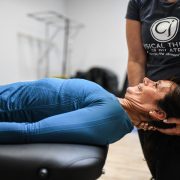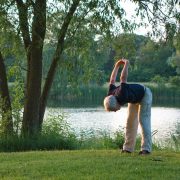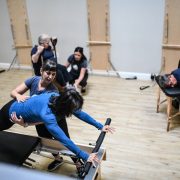3 Reasons Your Neck Stretches aren’t Working
If you suffer from chronic neck stiffness or even pain – and you’ve done your due diligence when it comes to neck stretches – it’s time to consider you might be missing something.
It could be your stretching technique, you could be doing the wrong stretch altogether, or it could be that you shouldn’t be stretching your neck at all…
Let’s go over three reasons why your neck stretches might not be working and help you pinpoint where it’s going wrong…
1. You’re using the wrong stretching technique.
Although research studies are inconclusive regarding how long you should hold a particular stretch, most people feel good when they hold a stretch for 30-60 seconds. When it comes to technique, one of the biggest problems I see is not relaxing enough. If you’re tense, or gripping your muscles at the same time you’re stretching, it won’t work very well. It’s important to breathe and move easily into the stretch. If you try to force it or push through pain, you’ll likely tense up.
Now let’s say you’re doing everything right (not tensing or gripping) but your stretches still don’t seem to work. Some people (myself included) respond better to “moving stretches”. This is where instead of holding one static position for a prolonged period, you repeatedly move through one (or several) end-range stretches. Neck rolls are a great example of this. If your neck stretches haven’t been working, try adjusting the way you’ve been stretching. If you notice a difference right away then you have your answer – you were likely using the wrong stretching technique.
2. You’re doing the wrong type of stretch.
This one could be a little tougher to figure out on your own. There is a difference between corrective neck stretching and stretching to feel good.
For example, let’s say your neck is tightening up because you’ve been under a lot of stress or you just did a lot of activity that stressed your neck out. Generic neck stretches such as bringing your chin to your chest, or pulling your chin to the opposite shoulder (known as an upper trap stretch) may be all you need.
In fact, I do stretches like this regularly because I’m constantly leaning over to help patients. I stretch my neck to PREVENT it from having problems and because it feels good. But let’s say you already have a neck problem, or you have pain or numbness running down your arm. In these instances, generic neck stretching could make you worse. You likely need corrective stretches for your neck. Corrective stretches are specifically prescribed to address a particular problem, and prescribed at a specific frequency. They are different from the generalized stretches that are designed to feel good and relieve tension.
3. You shouldn’t be stretching your neck at all.
This is a very common problem we see here in our office. Folks come in with complaints of chronic tightness and discomfort in their neck and no matter how often they stretch or massage, it doesn’t go away.
Did you know that chronic neck tightness can be a sign of a weak core?
It’s quite common, and if that is the case for you, no amount of stretching will help (and can even aggravate your problem!) The deep, stabilizing muscles of your neck are connected by fascia to the deep muscles of your core. If your deep core is not working properly, then your neck will often kick in and try to help.
Ever notice that your neck is always sore or tight after a good ab workout?
This could be a sign that your neck is compensating for your core. Stop stretching your neck, learn how to strengthen your core the right way, and see a specialist who can help you.
If you’re dealing with chronic neck problems that aren’t responding to stretching, there’s a good chance you could be not stretching correctly, the stretches aren’t right for you, or you’ve completely missed the root cause of your neck pain and you shouldn’t be stretching at all.
Consider talking to a movement specialist who understands how to figure this out so you can get rid of your neck pain and back to all the activities you love!
Are you local to Portsmouth, NH?
Book a free discovery visit with one of my specialists HERE.
They will ask you all about what’s been going on – and help you make the best decision moving forward – whether that’s working with us not!
Dr. Carrie Jose, Physical Therapist and Pilates expert, owns CJ Physical Therapy & Pilates in Portsmouth and writes for Seacoast Media Group. To get in touch, email her at [email protected].






